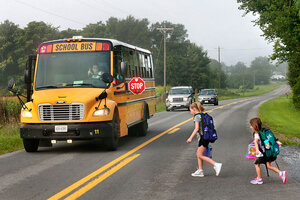The promise of a new school year
A new school year is full of possibility. In some cases, that can mean overcoming pernicious stereotypes about students' limitations.

Isabella Belford (l.) and her sister, Violet, catch the bus for their first day of school near Stephens City, Va., on Aug. 16.
Ginger Perry/The Winchester Star/AP
The start of a new school year can be a time of new possibilities: new classes, new teachers, new friends, a fresh start.
Actual classroom experience can sometimes convey a less promising message: teachers that just don’t seem all that convinced that all children – especially you or yours – can succeed. Disappointing grades, unambitious curriculum, and grim comparisons with students in other countries signal diminished prospects and not-so-great expectations.
Many parents fight for their children by confronting teachers and administrators directly when things aren’t going well – or by changing schools, hiring tutors, or moving into a better school district.
But some of the greatest gains have come by challenging directly the modes of thought that limit students’ capacity to achieve. In that fight, there have been notable and enduring victories.
Here’s one. When Henry Fowle Durant founded Wellesley College (for women) in 1875, he included an element considered risky at the time: athletics for women. The prevailing view was that too much exertion would threaten a woman’s capacity to reproduce. By 1908, organized sports at Wellesley included baseball, basketball, field hockey, tennis, rowing, archery, and running. In 1972, Congress passed a law (Title IX) that requires that women and men be provided equitable opportunities to participate in sports.
Some of the limiting modes of thought for children are as subtle as a line slipped into a report. At the turn of the 20th century, only about 1 in 10 students in the US made it from eighth grade to high school. The middle school movement aimed to change teaching methods to help bridge that gap. But as late as 1982, the influential founding document of the Ohio-based National Middle School Association argued that there is danger in pushing students to succeed academically, arguing that brain development slowed down in middle school years. This “brain plateau” meant it was risky to introduce algebra or advanced math into a middle school classroom – an assumption that wasn’t widely challenged until the end of the century.
Perhaps the most significant change in thinking in education since then has been to widely debunk the notion that intelligence can be measured by a standardized test. In 1925, the College Board created the Scholastic Aptitude Test, designed to measure a student’s capacity to learn – that is, “to understand the relations of discrete facts to one another and to apply them to new and unexpected situations.” As SAT scores morphed into gatekeepers for college admissions, a cottage industry of private test prep courses grew up around it. What the courses proved was that students could significantly improve scores by paying to practice test-taking skills (at today’s rates, $600 to $1,000).
During their day, expert opinions that limited students always seemed ironclad. Now, many are debunked. We invite our readers to send in more examples they see. These victories over limitations are worth remembering, especially at the start of a new school year.

